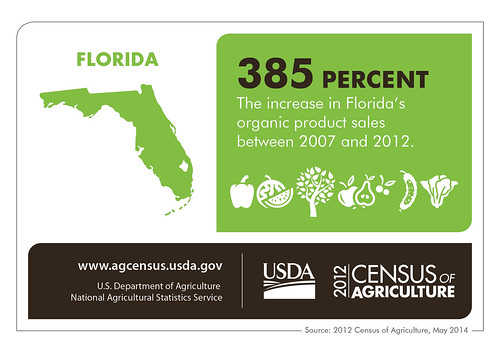
The Census of Agriculture is the most complete account of U.S. farms and ranches and the people who operate them. Every Thursday USDA’s National Agricultural Statistics Service will highlight new Census data and the power of the information to shape the future of American agriculture.
As the new Florida State Statistician, I am excited to start digging into the agricultural data here in the Sunshine State. One of the first things anybody would notice upon glancing over our stats is the wealth of fruits, vegetables, and other unique commodities. According to the 2012 Census of Agriculture, almost 64% of Florida’s total market value of agricultural products sold comes from three categories: (1) fruits and nuts, (2) nursery, greenhouse, floriculture, and sod, and (3) vegetables, melons, potatoes, and sweet potatoes. We are one of the top three states nationwide in sales in all three of these categories, and Florida is also the top producer of sugarcane for sugar. Thus, the Sunshine State definitely lives up to its bright nickname by harvesting a rainbow of commodities.
If one crop defines Florida, it’s oranges. There are over 465,000 acres of orange farms in our state, accounting for almost 70% of all the orange acreage in the nation. To top it off, we are the only state to grow the delectable Temple orange.
In addition to oranges, Florida has over 850,000 acres of farmland dedicated to other commodities: over 250,000 acres to growing vegetables, and over 598,600 acres producing more fruits, nuts, and berries. Interestingly, peaches in particular are coming into the Florida agricultural spotlight. Peach trees require chill hours to jolt their flowering process effectively, and while peach producing states like Georgia and New Jersey receive adequate chill hours for traditional cultivars, Florida usually does not. However, researchers have developed new cultivars with low chill hours which are more conducive to Florida’s growing season.
On another note, Florida’s farm demographics clearly reflect the dynamic and diversifying U.S. population. Since the last census of agriculture in 2007, there has been an increase in the number of Asian, black or African American, Native Hawaiian or other Pacific Islander, and Spanish, Hispanic, or Latino origin operators. Furthermore, while around 20% of farmers nationwide have been operating a farm for fewer than ten years, this proportion is almost 26% in Florida, reflecting a younger group of operators. Finally, about 35.7% of all farm operators in Florida are female.
Florida is also keeping pace with the recent trends toward renewable energy and organic products. At over $83 million, Florida’s 2012 total organic product sales was almost five times higher than in 2007. In addition, 748 farms in Florida have renewable energy producing systems.
As you can see, Florida agriculture is as vibrant as ever, and I am excited to see how our state continues to live up to its bright nickname.
